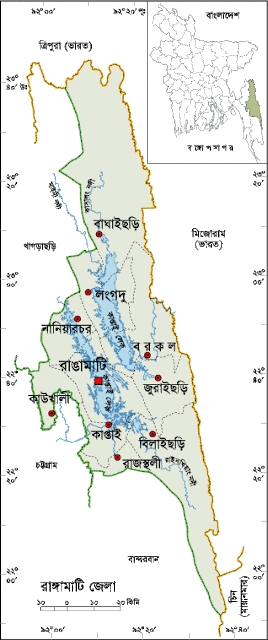Rangamati District, Bangladesh
Rangamati is a hilly district of Bangladesh located in the south eastern part of the country. The Geo position of the district is between 22˚27’ to 23˚44’ north latitudes and between 91˚56’ to 92˚33’ east longitude. It is the largest district of Bangladesh in area and the area of the district is 6,116.11 Sq Km. Before the formation of three districts the greater Chittagong Hill Tracts was called “Carpas Mahal (1715-1860). The population of this region mainly depends on agriculture and natural resources from forest for their livelihood.
History of Rangamati District
Before the Muslim conquest, Rangamati region was a contesting ground between the kings of the Arakan and the Tripura. As a result the Royal dynesty’s founder King Juja Rupa (Bira King) defeats the king of Chittagong and transferred his capital in Rangamati in 590 AD. Arakan King Tsula Tsandra (951-957) conquered Chittagong including Greater Chittagong Hill Tracts in 953 AD. In 1240 Tripura King re-Conquered the region. In 1266 this region came under the Mughals. It was leased to the English East India Company in 1760-1761. In 24 June 1787, formerly ruler Arakan King wrote to the chief to Chittagong that some tribes (Mogh, Chakma, Murang and Lice) took shelter in Chittagong Hill tracts and persecuted the people of both countries. Arakanis King wished to drive out the robbers so that the friendship between the two countries remain clean and the roads to transport the businessmen and tourists remain safe. In 1829, the commissioner of British East India Company recognized that the inhabitants of mountaineer are not British subjects but taxpayer only. According to the Act XXII In 1860, the region was separated from Chittagong that effected from 20 June in the same year and started its journey as a district. In 1868, the district headquarter was shifted from Chandraghona to Rangamati. After the liberation of Bangladesh, in 25 February 1985 due to administrative reform, Rangamati, Khagrachari and Bandarban district newly named and reformed.
How many Thana and Union in Rangamati District?
Rangamati district is under Chittagong Division. There are two Municipalities in Rajgamati named Rajgamati and Baghaichari. The number of Thana in Rangamati district is 10, named- Bagaichari, Langadu, Naniarchar, Rajasthali, Barkul, Rangamati Sadar, Kawkhali, Belaichari, Kaptai and Juraichhari. There are 49 Unions, 162 Mauzas and 1555 Villages in Rangamati district.
Why is Rangamati District Famous For?
Rangamati district is famous for having the one and only Hydraulic power plant in Bangladesh and historical artificial lake called Kaptai Lake. Rangamati district is also famous for Cashew-Nut, Citric fruits and Kaptai Lake based fish production. Rangamati is one of the top tourist destination in Bangladesh.
Famous Persons from Rangamati District
Famous persons born in Rangamati district are- Alamgir Kabir (Film Director), Kanak Chapa Chakma, King Debashis Roy, Raja Tribid Roy (Former Chakma King), Moharaja Tridib Roy, Moharany Moitry Roy, Barister Debashis Roy, Ashok Kumar Dewan, Krishna Kishor Chakma, Moni Shopon Dewan etc.
Tourist Attractions in Rangamati District
Tourist attractions in Rangamati district are- Sabuj Pahar, Home of Chakma King, Hanging Bridge and Parjapan Motel in Tabalchari Deer Park, Kaptai Lake, Hydro Electric Power Plant, Hard Board Mill, Karnafuli Paper Mill, Baghai Chari Kashalong River, Buddhist Bihar, Shuvolang Falls, Tribe Museum, Kaptai National Park, Peda Ting Ting, Tuk Tuk Eco Village etc.
Rangamati District Bordered By-
Rangamati District is bordered by Tripura and Mizoram (Indian State) to the north, Bandarban district to the south, Mizoram (Indian State) and Chin State (Mayanmar) to the east, Khagrachari and Chittagong district to the west.
Rangamati District Population
The total population of Rangamati district is 666,627. Sex ratio is 111:100, Tribal and Non Tribe ratio 52:48, Population Density 109/Sq Km and annual growth rate is 0.64%. The Literacy Rate of Rangamati district is 85.62%, school attendance rate is 79.29% for 5 to 24 years age group.
Rivers in Rangamati District
Rivers flow throughout Rangamati district are- Karnafuli, Shankha, Rankhiang, Kashaling, Mayani etc.
Agro Products in Rangamati District
Agro products grow in plenty in Rangamati district are- Paddy, Jute, Potato, Cotton, Pine-Apple, Banana, Jack-Fruit, Orange, Litchi, Oil seeds, Cashew-Nut etc.
Other Important Data: The postal code of Rangamati district is 4500 and NWD Code is 0351. Total Parliament seat in Rangamati is 01. During the liberation war, Rangamati was under Sector Number 01. The number of tribal live in the district is 11 and urbanization rate of the district is 26.78%. The highest peak of the hilly district is Thang- Nang (2409 Feet). The main traditional festival of the tribe inhabitants is Bijhu Festival.


No comments:
Post a Comment
Thanks for commenting my blog. Your comment will publish very soon.